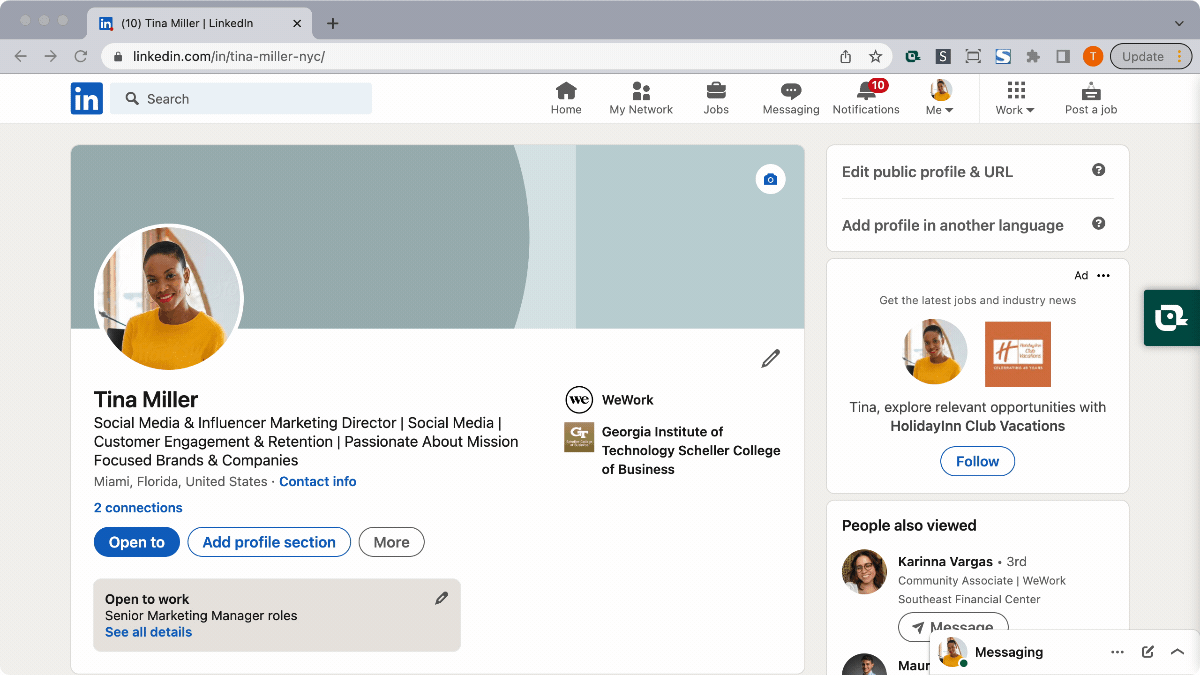No matter how a company delivers the news, finding out you’ve been laid off feels absolutely awful—the heart-sinking, stomach-flipping, sweaty palms type of awful. In an age where round after round of layoffs floods LinkedIn each week, more talented individuals than ever are experiencing this painful career phenomenon. And unfortunately, knowing what to do if you’re laid off doesn’t come naturally.
No one expects to go through this situation. As unfair, unpredictable, and unpleasant as layoffs are, though, you’re going to be okay. With a few key steps, you’ll handle the situation with grace and move forward in your career. Trust us—even if you’re overwhelmed and feel totally lost, everything is going to work out in your job search.
In the meantime, let’s discuss what to do after being laid off so you can persevere through this experience and move on to your new chapter.
What Does It Mean To Be Laid Off?
Companies lay off employees by temporarily or permanently terminating employment. Being laid off is not always a reflection of your individual performance; it may be the result of a company downsizing, restructuring, or economic circumstances. Though this likely doesn’t help ease the sting in the moment, a layoff doesn’t hurt your marketability or chances of success in the job market.
A layoff isn't the same as a termination for a performance or behavioral reason. When a company is in any sort of decline—whether in a slow season, economic recession, or other reasons—executives may decide to lay off employees to cut costs.
Layoffs also differ from furloughs, which are when a company temporarily suspends work for certain employees but keeps them at the company with the same title and benefits.
If you’re laid off, you’ll retain your investments in any company retirement plan, like 401(k)s. You might be entitled to a severance package, and will qualify for government unemployment benefits, but the bottom line is that you’ll lose your income and benefits.
Although just one person constitutes a layoff, often, companies implement large layoffs and cut groups of employees ranging from hundreds to thousands.
Details You Should Confirm With Your Employer During Layoffs
Please note: We aren’t legal professionals, so this information does not constitute legal advice. Consult with an employment lawyer or legal professional if you need additional information or support.
#1: Separation Agreement
In the United States, employees being laid off will be asked to sign a separation agreement. This document is meant to protect the company from potential legal woes down the line — it ensures that you, as the laid off employee, cannot take further legal action against the company. The larger the company, the more they’ll want you to sign this agreement.
But you aren’t legally required to accept the separation or severance agreement the company provides. It’s actually possible to negotiate better terms for yourself, even if you’re given a standard company-wide agreement. Speak with a lawyer to better understand what the company’s asking you to sign, and to find out whether you should negotiate some of the terms.
#2: Severance Packages
Though it isn’t required by law in most cases, many employers conducting layoffs will offer a severance package to the affected employees. Severance pay is basically compensation a company pays to you if they decide to terminate your employment for non-performance reasons. Sometimes, companies offer severance packages paid out as one lump sum, and other times they’re paid out over a period of time.
If your employer offers you a severance package, it’s worth consulting a lawyer to review the terms and make sure things are fair. Severance can be very tricky to negotiate, particularly during a mass layoff, but in some cases it’s worth a shot. Sometimes, employers won’t negotiate the severance package itself, but will agree to other benefit payouts, like unused PTO or extended health insurance contributions.
#3: Logistics, Like Your 401(k)
If you have a 401(k) account with your employer and you’re laid off, there are a few options to evaluate. Sometimes, you can leave it with your former employer for the time being while you consider your options. Often, though, it’s better to transfer the funds to your new employer when you get hired somewhere else, or to an Individual Retirement Account (IRA).
To avoid tax liabilities, you’ll want to transfer the balance to one of those options instead of pulling the money out of the 401(k) account.
What To Do Immediately After Being Laid Off
When you find out you’ve been laid off, it’s common to panic. Whether you just joined a company and adored the culture, or you’ve been an employee on the team for years with no plans to pivot, layoffs hurt, and more importantly, throw off your balance.
While the laws around workforce reductions vary by location and employer size, there are steps anyone can take to help cope with being let go. Here’s what you should do immediately after being laid off.
Take Time To Process
Don’t start panic-scrolling LinkedIn looking for open positions and employment as soon as you get this news. You deserve time to process and take care of yourself.
Practice self-care, hydrate, talk with a family member and loved ones, and do your best to prioritize your wellbeing. Spend at least a day (preferably a few) processing and taking care of yourself before leaping back into the job search process.
Update Your Resume, Even If You Aren’t Ready To Apply
Even though you’re probably not feeling warm and fuzzy towards your former employer, now is the time to focus on your wins and accomplishments during your time at the company. After you’ve taken some time to process, open your laptop and update your resume.
Even if you’re not ready to start actively looking for employment, one of the best things you can do is to update your application materials while your wins and achievements are still fresh in your mind.
Use Teal’s AI Resume Builder to create an ATS-friendly resume. Once you add all of your accomplishments, when you are ready to start applying, you’ll be able to tailor your resume by picking and choosing what to include and aligning with individual job descriptions.
As you focus on capturing your achievements while they’re top of mind, document everything in one place (Teal’s AI Resume Builder is the most convenient spot, since you’ll be able to use that information again and again in your resumes). Remember to use metrics as much as possible, especially while you’re still in touch with coworkers who may have insights on your projects.
The job of your resume is to get you in the door. Optimizing it will help you land interviews for the next opportunities that excite you. Teal’s free AI Resume Builder can help you keep your Work History up to date and help you write metric-driven achievements using our Achievement Assistant tool.

Optimize Your LinkedIn Profile
Once your resume is polished, move over to LinkedIn. Before you post anything about the layoff or that you’re open to work, you want to optimize your profile. These types of posts can garner a lot of engagement, meaning lots of eyes on your profile, so you want to be prepared.
Teal’s LinkedIn Review tool provides strategic recommendations for you to optimize your profile. It’s so easy to use with a convenient browser plugin, and helps you instantly spot actionable areas to improve your profile.

As you optimize your profile, be sure to adjust your headline…but don’t waste precious character real estate saying you’re open to work. Instead, toggle your profile to show as ‘open to work’ with LinkedIn’s #OpenToWork feature…and write a compelling headline that’ll attract attention more organically.
Then, go ahead and craft your open to work post. You can keep it general or share your feelings about the layoff — go with what feels authentic to you. This is an awesome opportunity to get support from your network and even open the door to new business opportunities.
When You’re Ready, Start The Job Search
When you feel up to it, dip a toe back in the job search world. You don’t have to be hard on yourself at this point — instead, think of this step as window shopping. You can add opportunities to your list that interest you, but there’s no pressure to actually commit yet.
As you start researching jobs and spotting potential matches, it’s essential to stay organized. Teal’s Job Application Tracker helps you organize all of the jobs you’re interested in, which you’ve applied to, and what stages you’re at with each role.

It even has a keywords feature that’ll help you identify patterns to broaden your job search based on what you’re consistently drawn to.

When it’s time and you start landing interviews, spend time preparing. Your confidence might feel shaken because of the layoff, so practice how you’ll share details and what you’re going to say.
Within Teal’s Job Application Tracker are tips and resources to help you practice interviewing.

But remember, this wasn’t your fault — you’re highly qualified and the right company is going to see that right away. You’ve done successful interviews and landed roles before, so it’s only a matter of time before you bounce back completely and that layoff is a thing of the past.
Teal is here to support you during these difficult layoffs, and throughout your new job search process. With lots of resources, like the LinkedIn Review tool, AI Resume Builder, Job Application Tracker, you’ll be able to strategically approach your next steps and redirect your career without being overwhelmed. Remember, you’re going to be okay, and this chapter won’t define your career (and for more information, be sure to read our comprehensive playbook to navigate layoffs).









